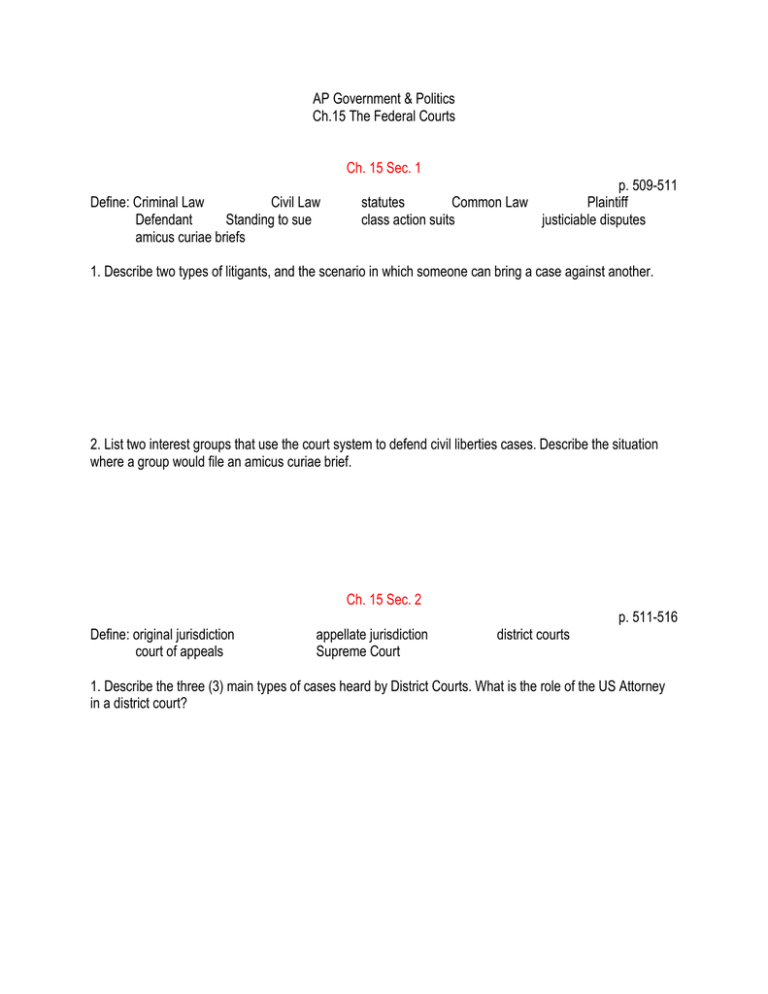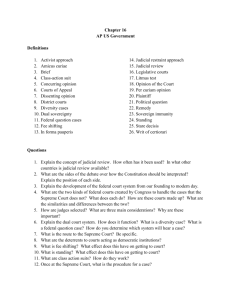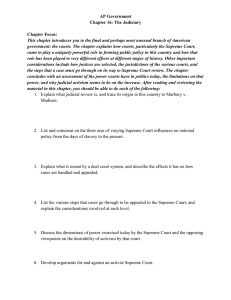Ch. 15 Reading Q's
advertisement

AP Government & Politics Ch.15 The Federal Courts Ch. 15 Sec. 1 Define: Criminal Law Civil Law Defendant Standing to sue amicus curiae briefs p. 509-511 statutes Common Law Plaintiff class action suits justiciable disputes 1. Describe two types of litigants, and the scenario in which someone can bring a case against another. 2. List two interest groups that use the court system to defend civil liberties cases. Describe the situation where a group would file an amicus curiae brief. Ch. 15 Sec. 2 Define: original jurisdiction court of appeals appellate jurisdiction Supreme Court p. 511-516 district courts 1. Describe the three (3) main types of cases heard by District Courts. What is the role of the US Attorney in a district court? 2. Describe the main role of the Court of Appeals? Why do they not hear testimony or hold trials? 3. What determines the number of Justices sitting on the Supreme Court? Describe two types of cases the Supreme Court will NOT hear. Ch. 15 Sec. 3 p. 516-521 Define: Senatorial Courtesy 1. Describe the situation in 2009 where Senate Republicans changed senatorial courtesy. Why is this issue important to Senators in states that may disagree with Pres. Obama’s judicial nominee? 2. Describe three (3) reasons why did the nomination of Harriet Miers create a problem for former Pres. Bush. Ch. 15 Sec. 4 p. 521-525 1. Describe two (2) background characteristics that many federal judges have in common with one another. 2. Describe how partisanship and ideology become a factor when selecting a federal judge. Ch. 15 Sec. 5 Define: "rule of four” opinion writ of certiorari solicitor general stare decisis precident originalism p. 525-532 per curiam decision judicial implementation 1. Describe the process the justices go through to pick the cases they hear. What types of cases are they most likely to hear? 2. List the four functions of the solicitor general. Why is their job so important to the US government? 3. Describe the process (starting with the role of the attorneys) in deciding a Supreme Court case. Why is writing the opinion such a critical step in the decision making process. 4. Describe the two forms of the theory of originalism. What are two opposite theories used to counter orginalists? 5. Describe the three (3) elements involved in enforcing a Supreme Court Decision. Create a scenario that fits each of the groups mentioned in your text. Ch. 15 Sec. 6 Define: Marbury vs. Madisen judicial review p. 532-536 1. What did FDR mean by calling the Supreme Court Justices “Nine Old Men”. What did he do to try to change the Court during his time as president? 2. Describe each of the major accomplishments of each of the “courts” listed below: Warren Court: Burger Court: Roberts Court: Ch. 15 Sec. 7 Define: judicial restraint Statutory construction judicial activism political questions p. 536-541 habeas corpus 1. Describe two ways Court decisions have helped promote democracy in the last 50 years. 2. Provide 2 examples of how amendments have been used to overturn judicial decisions. 3. How did the Supreme Court overrule former Pres. Bush in 2004.








